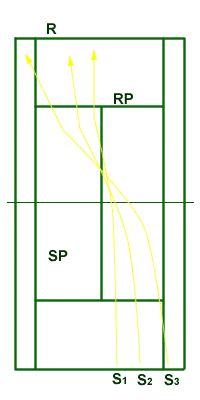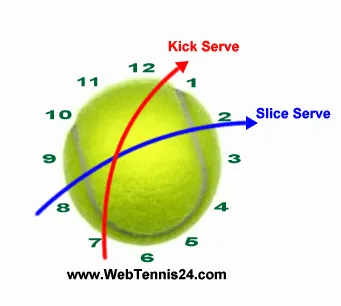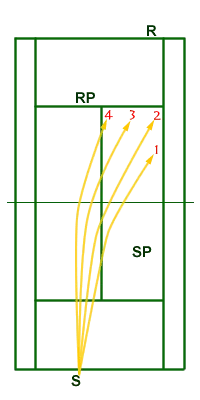In doubles play, the server can position himself anywhere between the center and the doubles sideline (as long as he doesn’t step on or inside the baseline).

In the above graphic, we see three positions from where the server can deliver the ball:
– S1 - close to the center mark,
– S2 - about halfway between center and doubles sideline,
– S3 - closer to the doubles sideline.
Most of the players prefer to position at S2 to serve, but if you are looking to set your net partner up for a poach you should consider serving from the S1 position.
The S1 position allows the server to deliver the ball down the T (intersection of the service line and center line). That closes the angles for the receiver (R) allowing him to return down the middle – which sets up the poaching opportunity for the opposing net player (server’s partner – SP).
Some players might not like serving from the S1 position thinking that they would have to move very fast to cover the cross-court, but if you consider the position from where the receiver makes contact with the ball and also his partner (RP – receiver’s partner) obstructing his cross-court delivery, that shot will be less likely to happen.
The server can also consider serving from the S2 or S3 positions in order to create angles and get the receiver off the court and open the gap between the opposing two players but that would not be a good idea to implement considering that a wide serve can open the court in many ways for the returner too.
So from a tactical point of view, the S1 position serving down the T would be ideal because:
– it closes the angles for the returner;
– it sets up the net player to poach;
– the ball travels over the lowest part of the net.
I’d recommend serving from position S1 most of the time but in order to keep your opponents honest, vary the position to either S2 or S3 sometimes.
Tip: You will have to talk to your partner at the net to position himself a little closer to the sideline so that you can execute some angle serves if you want to (from the S1 position); he will move back in position after the serve is delivered.
------------------------
The main types of spin on the serve are flat (very little spin), slice (side spin), and topspin/kick.
To explain the rotation imparted by the three types of serves we’ll imagine the ball as the face of a clock… The top of the ball is 12 o’clock, the far right side is 3 o’clock, the bottom of the ball would be 6 o’clock and the far left side is 9 o’clock (see the graphic below).

Flat Serve (very little rotation imparted on the ball)
To hit a flat serve, the racquet should impact the ball right in the middle (where the arms of the imaginary clock should meet). The result is a ball traveling at the highest speed with very little rotation.
The flat serve is powerful but inconsistent. In order to hit the ball in the service box hard and on a consistent basis, the contact should be made very high. Otherwise, the serve will land either in the net or deep beyond the service line most of the time.
Mostly used by beginning players, the flat serve is hit slowly in order to be hit in. The so-called Flat Serve that the pro players achieve such amazing speed is in actuality a combination of velocity and slice spin… Each serve in order to go in if hit hard must have some sort of spin associated with the high velocity.
To hit a flat serve, the ball should be tossed farther out in front of the body, in the direction of the target.
Slice Serve (side spin)
Slice serve has the ball rotating from left to right (from a right-handed) which is achieved by brushing on the back of the ball sideways from 8 o’clock towards 2 o’clock (or 9 to 3 o’clock) - see the attached graphic.
The slice serve makes the ball stay low as it crosses over the net and stays low after the bounce too. Also its trajectory curves to the left (if hit by a right-handed player).
To achieve the slice on serve, the ball should be tossed slightly to the right in order to facilitate the left-to-right brushing motion on the back of the ball.
Topspin / Kick Serve (“over the top of the ball” rotation)
The topspin serve is the most consistent serve of all considering the mechanics which allow the ball to go high over the net and land quickly due to the “up and over” rotation of the ball. (see graphic)
To hit a ball with topspin, the player should toss it a little over the left shoulder and the brushing motion should be done with the racquet swinging up on the down-coming ball. The friction between the racquet and ball should create an “up and over” rotation or from 6 o’clock to 12 o’clock or 7 to 1 o’clock (picturing the ball as the face of a clock).
Because the ball is spinning from bottom to top it will start out high over the net and then drop quickly into the court. That makes the topspin serve the number one choice for consistency.
How to Use the Spin to Your Advantage
Flat Serve
Use it mostly as a first serve when you can afford to take a little risk. Associated with a little slice it could go in if hit hard.
Targets:
– into the body or down the T considering that these are areas towards which the ball travels over the lowest part of the net.
When to use it:
– first serves, when you have a considerable lead (e.g. 40-0, 40-15).
Slice Serve
Very effective serve, the slice serve keeps the ball low (making the returner hit the ball up), and can be used either on the first as well as on the second serves.
The spin makes it harder for the returner to deliver a controlled ball.
Targets:
– from the deuce side: either down the T so that the left curve off the bounce will send the ball into the returner’s body, or wide to pull the player off the court.
– from the ad side: hit it wide (close to the sideline) so that it curves into the returner’s body, or aim at the body to curve it to a left-handed player’s backhand.
When to use it:
– first or second serves; anytime you want to set your net partner up for poaching; to jam the returner with an into-the-body shot; pressure situations.
Topspin Serve
The favorite as a second serve, the topspin serve is well known for its ease to get the ball in safely with a good margin for error.
Targets:
– from the deuce side: hitting the topspin serve down the T toward the returner’s backhand, or into the body.
– from the ad side: wide (close to the sideline) to the returner’s backhand; either into the body or down the T.
When to use it:
– anytime (first and second serves for variety); pressure situations.
First of all… get the first serve in! Do not rely on your second serves at all! You might as well take some pace off of the first serve in order to get it in.
If your number one priority of the serve is to get it inside the box, number two would be placing it wherever you HAVE TO. It is not enough to make it in. You have to make sure that based on the delivery of your serve your team will be either in an offensive or defensive mode.
The accuracy of your serve depends on certain factors:
– position behind the baseline (the closer to the center the easier to serve down the T, the closer to the sideline the easier to create an angle)
– the ability to impart the desired spin (e.g. a wide serve with a heavy slice from the ad side makes the ball curve into the body if delivered by a right-handed player)
– and ultimately, the ability of the server to hit the ball to the desired area inside the box (that comes with a lot of target practice).
Tactically, the decision to go to a certain target relies on the following:
– whether the net partner is willing to poach the return
– whether it is the first or second serve
– the score
– receiver’s position, movement, and technical abilities.
In all cases, the DEPTH of the serve is crucial considering that failing to do so allows the opposing team to attack.
The main serving targets are (see graphic below):

1 – wide short
2 – wide deep
3 – into the body (down the middle of the box)
4 – down the T (close to the center service line)
We’d suggest that you communicate to your net partner your intention of serve placement so that he can move to cover the court accordingly.
Let’s discuss in detail when and why you should be serving each of the aforementioned targets.
Target 1 – wide short (1 out of 10 times)
This is a risky shot to make considering that the server has to hit the ball over the highest part of the net and also make sure that his net partner is not hindered during the delivery.
Advantages:
– gets the receiver off the court, opening the gap between the opposing players
– the opposing team must move sideways and thus open the court.
Disadvantages:
– opens up the court for the receiver giving him a lot of angles to work with (down the alley, short cross-court, lob, etc.)
– very hard to cover the court considering the wide angles that this serve offers the receiver.
– hard to execute.
This target should be aimed only at certain situations like a receiver having a weak side, or just to mix it up to get the opposing team guessing.
The server should warn his net partner of this intention so he can cover the alley at the appropriate time.
Target 2 – wide deep (1 out of 10 times)
This is a serve target aimed to exploit a weakness (e.g. serving to the receiver’s backhand to the ad side) but it should not be used too often.
Advantages:
– if used to exploit a weak shot it induces a weak reply or error.
Disadvantages:
– gives the receiver many angles to work with putting the server’s net partner in a difficult situation;
Target 3 – into the body (4 out of 10 times)
One of the smartest serve placements in doubles, it puts the receiver in a very defensive mode resulting in a slow, floating ball that sets up the server’s net partner for an aggressive put-away.
Advantages:
– weak reply from the receiver
– low net clearance for more consistent delivery
– sets- up the net player for a put-away shot.
Disadvantages:
– none that we can think of…
Use this target a lot during the match.
Target 4 – down the T (4 out of 10 times)
Same as target 3, target 4 is very efficient first of all because the ball travels over the lowest part of the net, and second, the receiver has very limited angles to work with.
Basically, the only way for the receiver to return the ball would be down the center which sets up the server’s net partner for a poaching put-away shot.
Very effective target to use when intending to serve and move up to the net. It is very important that the server communicates with his net partner about his placement intentions so that he can move and plan accordingly.
The before-mentioned tactics refer mostly to delivering first serve where you can allow yourself to take a little bit of risk. For the second serve, since it must be hit inside the box, our recommendation is that it should be hit with lots of spin and depth (we’ll cover the spin in the “Spin” section). This will make it harder for the receiver to control and attack the ball.
Depending on how good the server’s second serve is, the net player should either stand at the net or move back (see “Server’s Net Partner Position” section).
--------------------
Oh, the sweet speed…!!! Everybody loves it…
But take it from me: you won’t win with power only!!! (well, at least not often) It is consistency and placement that wins in the end (of course some other factors like tactics, conditioning, etc. contribute too).
But if you can deliver a serve fast and keep it in… then go for it; just make sure that you get more serves in than you miss.
We’ve seen the typical recreational player blasting a fast first serve into the net followed by a 10 mph flat second serve…
Don’t waste your first serve attempting to get an ace once every 20 tries.
Think about it: when your opponent is waiting for your first serve he plays defensively, behind the baseline. If you miss it, he will step forward to attack your second serve.
So basically you are wasting the opportunity to be the attacking player by missing the first serve.
My point is: get the first serve in even if that means you, sometimes, serve at about 60-70% power. You will be in control of the point from the start.
That does not mean you should serve slowly on the first serve all the time.
Mix up the speed so your opponent does not get comfortable returning it.